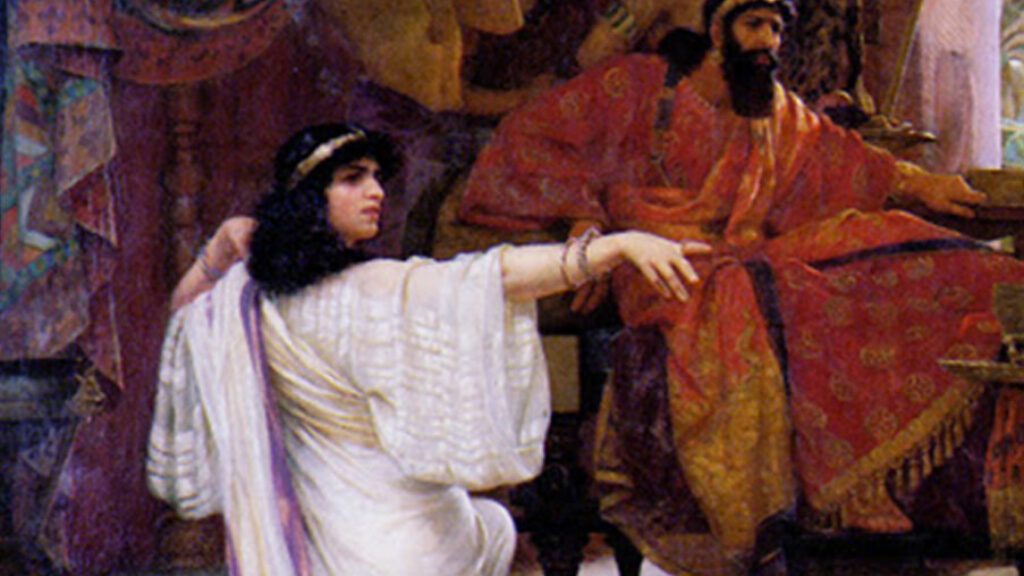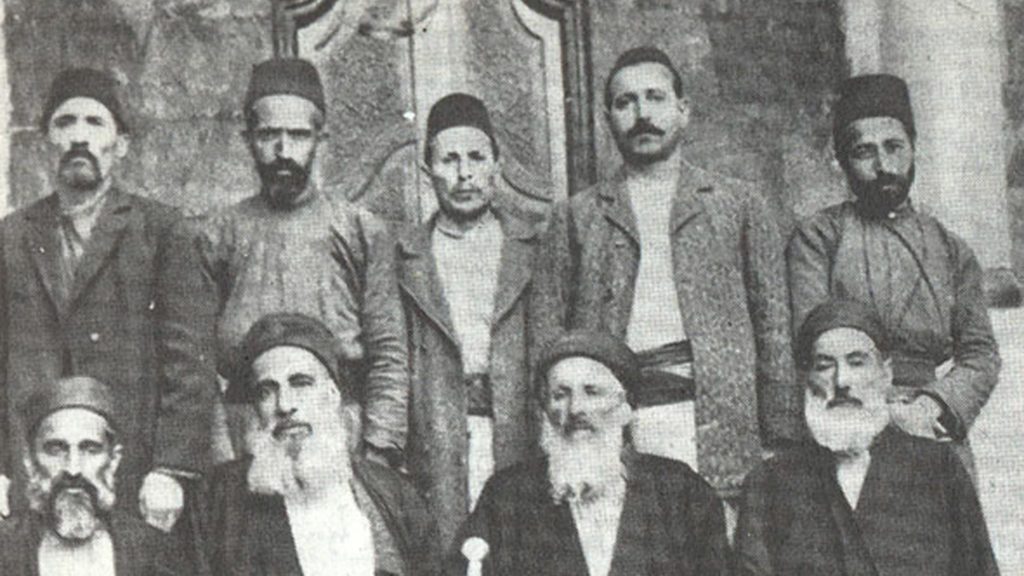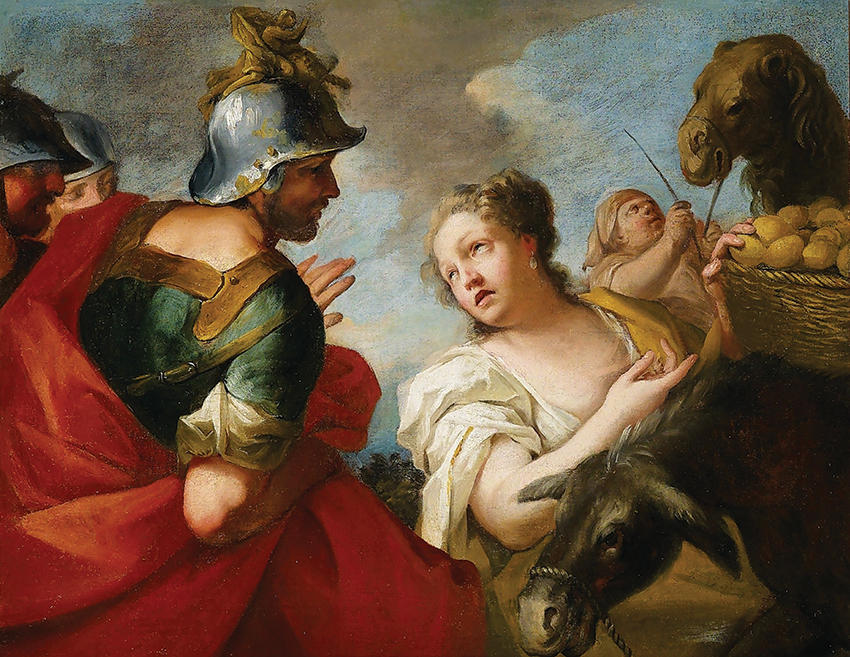The Bible’s Women in Medieval Ashkenaz
An amazing letter survives from fourteenth-century Egypt. In it, an impoverished Jewish woman complained that her husband, a bellmaker named Bashir, had been spending all his time at a Sufi collective on the Muqattam mountain near Cairo. Bashir’s wife worried that he would end up converting to Islam. Yet even if he remained Jewish, she had no patience for his mystical devotions:
If he wants to be pious, he might [try] going regularly to the synagogue for shacharit, mincha, and ma’ariv prayers, and to listen to a devar Torah—not busy himself with nonsense!
For Bashir’s wife, real piety began not with mystical contemplation but with basic Jewish communal prayer—and, she adds acerbically, with feeding one’s family. She and their three children were starving.
I thought about Bashir and his wife often while reading Elisheva Baumgarten’s Biblical Women and Jewish Daily Life in the Middle Ages. Baumgarten is a leading historian of medieval Ashkenaz (shorthand for the Jews who lived in present-day Germany and northern France). This was the birthplace of the enduring Jewish literary culture that later flourished across central and eastern Europe. Until recently, historians have tended either to examine the Jews of Ashkenaz as a beleaguered minority under Christian rule or to focus on the thought worlds of the rabbinic intellectuals among them—a handful of scholars (all men) who composed enduring works in Hebrew. In contrast, Baumgarten’s work emphasizes that the Jews of Ashkenaz were also actual people, just as much as Bashir and his wife. Alongside scholars such as Ivan Marcus and Ephraim Shoham-Steiner, she has pioneered the use of medieval rabbinic narratives, responsa, and commentaries to understand the rhythms of ordinary life in Ashkenaz.
The medieval texts don’t make this easy. But Baumgarten succeeds by taking rabbinic authors seriously on their own terms while also reading them sideways, with an eye to the stray clues about themselves that they dropped between the lines. Since these works focus overwhelmingly on religious thought and conduct, this approach naturally puts religion at the center of the story. Medieval European Jews didn’t leave us letters like the one we have from Bashir’s wife. But Baumgarten mines the Hebrew texts we do have to reveal how these medieval Jews—from the most erudite talmudists to bellmakers’ wives—understood themselves as religious subjects.
Consider the woman from medieval Ashkenaz whom historians know best: Dulcia, the wife of Eleazar ben Judah of Worms. In November 1196, two men (perhaps Crusaders) attacked Eleazar and Dulcia’s home and murdered her and their three children, Bellette, Hannah, and Jacob. We know this story because Eleazar, in his grief, “lacking everything, in poverty and in anguish,” wrote a long and beautiful poem in her memory.
Violence looms large in the history of Ashkenaz. In 1096, a century before Dulcia died, Jewish men and women in the Rhineland killed themselves and their children to escape marauding Crusaders who threatened to baptize them by force. Jews in Ashkenaz remembered these radical martyrs for generations. Their stories were so vivid, and so horrible, that modern historians have foregrounded them too.
But Eleazar did not memorialize Dulcia as a martyr. Instead, he remembered her as a pious woman, a hasida. And although Eleazar and his followers were ascetic pietists who called themselves Hasidim, the piety he had in mind was not ascetic; it was domestic. In Eleazar’s telling, Dulcia worked to support him so that he could study and buy books; she fed him and his colleagues; she helped outfit and marry off brides; she washed corpses and sewed their shrouds; she gave to charity; she made wicks to illuminate the synagogue and the local schools; she prayed and recited Psalms; she attended synagogue services; she visited the sick. Perhaps most strikingly, as Baumgarten notes, Dulcia also “bought and sold the parchment that was necessary for the ritual objects she made: handwritten scrolls of the Torah and other biblical books, tzitzit, and tefillin.”
Baumgarten has called the kinds of mundane religious actions and ideals that this poem highlights “quotidian piety.” Her past work approaches the subject mainly through ritual and social practices. Baumgarten’s first book, Mothers and Children: Jewish Family Life in Medieval Europe, painted a wonderfully intimate portrait of the ways in which Jews in Ashkenaz imbued childbirth, circumcision, breastfeeding, and child-rearing with religious meaning. Practicing Piety in Medieval Ashkenaz: Men, Women, and Everyday Religious Observance focused directly on the forms of piety that Eleazar attributed to Dulcia—acts like maintaining physical purity, fasting, and giving to charity.
Biblical Women is also about everyday piety in Ashkenaz, but it takes a different tack. The book examines not rituals but stories—specific biblical narratives that medieval Jews knew well. The Bible’s characters were everywhere in Ashkenaz. Jews remembered them whenever they prayed, when they attended births and weddings, when they opened the illuminated haggadot they read at Passover; their names were in the amulets they used to ward off harm.
They also identified the Bible’s men and women with themselves. Eleazar framed his memories of Dulcia around the “woman of valor” of Proverbs 31. Hebrew tombstones from Germany likewise connect the more ordinary medieval Jews who lie beneath them to biblical figures: “May she be joined to the mothers (imahot) in the garden of Eden”; “Like Deborah the wife of Lapidah [sic], her names were known at the gates.” The Bible’s stories are so ubiquitous in this material that Jews in Ashkenaz must have recalled them in other contexts too: in oral tales, teachings, and patterns of speech that left no textual traces.
Each chapter of Biblical Women spotlights a different biblical woman or a cluster of women: Eve; the matriarchs Sarah, Rebecca, Rachel, and Leah; Deborah and Yael; King David’s Abigail; and the daughter (anonymous in the Bible, although some later texts call her Seila) that Jephthah accidentally vowed to sacrifice.
Why women? Because medieval women rarely read and (so far as we know) never wrote formal Hebrew texts, it’s especially easy to spot commonplace religion where they’re involved. Given her abiding interest in looking beyond the elite, we might suppose that Baumgarten aims to find a popular female Jewish culture, distinct from that of (male) scholars. But that would miss the more interesting point that underlies this book: quotidian piety was not just for women and not just for nonrabbis. Most Jewish women in Ashkenaz could not parse the Hebrew Bible’s text, let alone the Talmud’s. But they did know who Eve and the matriarchs were. Men cherished Eve and the matriarchs, too, and often in the same ways. Commonplace piety transcended both gender and the popular-elite dichotomy. It was not a separate form of Judaism but something more diffuse: the basic assumptions about God, the cosmos, and their own behavior that most Jews in a given region shared, no matter how much else they knew.
This is not to say that quotidian piety was one-sided or unchanging. On the contrary, the Bible’s women held complicated, sometimes tangled, meanings in Ashkenaz. For example, Hebrew texts from medieval northern Europe routinely tie the biblical Eve to death in childbirth as well as to three domestic ritual practices: separating a portion of dough when baking bread (challah), maintaining menstrual purity (niddah), and candle-lighting before the Sabbath and holidays (hadlakat haner). This cluster of connections traces back to a Mishnah that states that women who don’t maintain challah, niddah, and candle-lighting may die in labor—an idea that naturally led exegetes to Eve, whom Genesis blames for birthing women’s pain. In Ashkenaz, Eve and the Mishnah’s dire warning appeared often in the regular liturgy. But Eve also hovered over happier depictions of the three commandments themselves, and wedding liturgies invoked her as a more general symbol of joy and fertility. She symbolized both women’s sins and women’s righteousness, the threats they faced and their protection from danger.
The lines separating quotidian and elite religious practices, as well as women’s and men’s piety, also shifted over time. An especially fascinating passage in Baumgarten’s earlier book Practicing Piety surveys evidence that women in early medieval Ashkenaz occasionally wore tefillin and tzitzit, which the Talmud requires only men to use. Were these women actively taking on male roles? Probably not. Rather, Baumgarten points out that only select Jewish men in eleventh- and twelfth-century Ashkenaz used tefillin and tzitzit. These items were the special province of small groups of relatives, men and women alike, who lived in households that produced and owned them. By the late thirteenth century, though, more Jewish men had begun wearing tefillin and tzitzit, and rabbinic authors increasingly discouraged women from doing so. Tefillin and tzitzit began in Ashkenaz as elite, nongendered practices but ended up as commonplace male practices.
Similarly, in the eleventh and twelfth centuries, wealthy Jewish women conducted business and often chose how and when to give money to charity. But then things changed: in the thirteenth century, rabbinic authors began to argue that women should not do business on their own or make their own decisions about charity. Yet charity remained so integral a part of everyday piety that not everyone agreed—and here Biblical Women demonstrates that the biblical Abigail came in handy. Some scholars reasoned that just as she went behind her husband Nabal’s back to bring David food, women whose husbands were too stingy to give to charity could do the same. In this case even Jewish scholars drew on a familiar biblical story to justify an everyday practice—women’s independent charity—that they had begun to question on more rarified scholastic grounds.
The Hebrew Bible mattered to all medieval Jews, no matter where they lived. But it’s no coincidence that biblical characters acquired such power in Ashkenaz, among Jews whose Christian neighbors shared the same stories. Until recently it was common wisdom that the region’s Jews had lived hermetically sealed off from the Christian cultures around them. There were good reasons to think so. After all, they had martyred themselves and their children to escape baptism during the First Crusade. Moreover, although medieval Jews in Iberia and the Middle East produced Jewish work in Arabic, Jews in Ashkenaz did not write equivalent works in Latin.
But it’s become clear that this apparent separatism is largely an illusion. Jews in medieval Worms, Paris, Cologne, and other northern European cities lived among and constantly interacted with Christians—as often and as closely as the Jews of medieval Cairo did with their own Christian and Muslim neighbors. Baumgarten’s earlier book Mothers and Children turned on the observation that Jewish children often grew up within households where Christians lived as wet nurses and domestic laborers, experiencing the same sights and sounds as children in Christian homes. Not surprisingly, Jews and Christians also shared similar rituals. Take circumcisions and baptisms: at both ceremonies, Jewish and Christian parents appointed ritual coparents— in Hebrew, ba’alei brit or, for the man, sandek—who washed and dressed the baby in a white gown and cap before carrying him in.
Ivan Marcus has called Christian Europe’s impact on medieval European Judaism “inward acculturation”: Jews may not have written in Latin, but their Hebrew writings reflect the Christian culture of the day. Biblical Women demonstrates that biblical knowledge helped make this acculturation possible on both ends. Like Jews, Christians remembered the Hebrew Bible’s women (alongside the New Testament’s) when they gave birth, fell ill, died, and prayed for the dead. In some cases they remembered the same things about them. Like Jews, Christians invoked Eve at weddings. Like Jews, they affirmed that women could not be married against their wills by remembering Laban, who in Genesis asks Rebecca whether she wants to marry Jacob. And even where Jews and Christians retold these stories differently, they shared common ground. For example, the biblical Jephthah’s daughter willingly died to fulfill her father’s foolish vow to sacrifice the next person who crossed his doorstep. For Christians, she symbolized monastic women who abandoned ordinary life for God’s sake; Jews instead exalted her as a virgin martyr.
The Bible’s women lived on and evolved in later Ashkenazi culture. Biblical Women follows each of its biblical heroines into early modern Yiddish writings—including one that a woman wrote in sixteenth-century Prague: Rivkah Tiktiner’s Meneket Rivkah. Tiktiner’s treatment of Eve is particularly poignant. Although most Yiddish writers of her time continued to tie Eve to pain and death in childbirth, Tiktiner linked her to a different kind of anguish: infertility, which she described as “the greatest distress” for some women.
The history of religion runs through quotidian beliefs and practices. It is worth our time to understand them. The historian of Syriac Christianity Jack Tannous has recently argued that “simple” Christians and Muslims profoundly shaped both Christianity and Islam in the early medieval Middle East, in part because they had more in common with scholars than we might think:
We must never forget that the theological elites who fought doctrinal wars lived lives dominated by pastoral concerns and saturated with prayer, fasting, and worship. It was out of the ground of these lived experiences that their doctrinal concerns grew.
It is not easy to recover such everyday concerns and practices for Jews in Ashkenaz—and given the sources we have, we will likely always understand these people’s quotidian piety better than their quotidian impiety. But Baumgarten’s ingenious scholarship demonstrates that these texts have a great deal more to say than we might have supposed. Much of Biblical Women will likely resonate with modern readers, including for the ways it illuminates some of our own concerns. But that is not the main reason I appreciated this book. Early medieval Jews in Ashkenaz and elsewhere called care for the dead hesed shel emet, “kindness in truth,” because the dead cannot reciprocate. Baumgarten’s clear-eyed and painstaking attention to her subjects is also an act of true kindness for these long-vanished people. Her book helped me care about them, their lives, and their moral imaginations purely for their own sakes, as all good social history should.
Suggested Reading
Standing at Sinai in Medieval Germany
An unusual illustration of revelation from the fourteenth century Tripartite Mahzor.
Inconceivable
Two new books push readers to examine the phenomenon of childlessness in the Jewish tradition and modern Jewish life.

Suspecting Esther
For Seymour Epstein, the Megillah depicts the cycle of passivity and overreaction that is endemic to the diaspora.

That in Aleppo Once
Does the most accurate biblical text belong in the synagogue, or in a museum?

Comments
You must log in to comment Log In